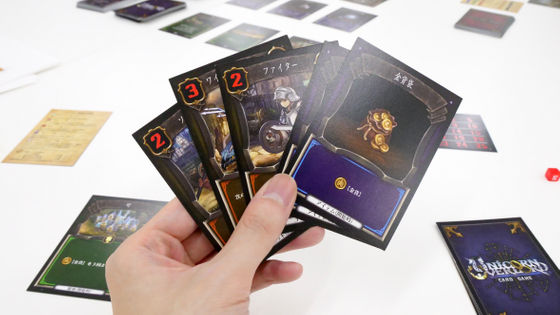A review of the expanded version of the board game 'Canvas: Reflection,' which allows you to complete paintings with transparent cards, by doubling the patterns of the game and making it possible to master art.

'
Canvas: Reflection Japanese Version - Engames Shop
https://www.engames-s.com/product/2320

Amazon | Canvas: Reflection Japanese version | Board games

You can see a play review of the basic 'Canvas' below.
A review of the game 'Canvas' where you can create a more beautiful painting than anyone else by overlapping transparent cards on a canvas - GIGAZINE

The package for 'Canvas: Reflection' looks like this:
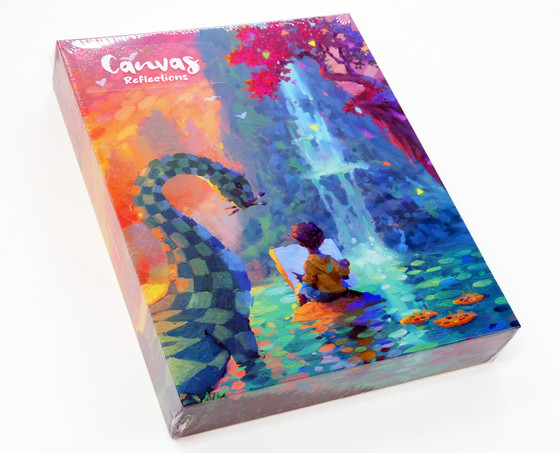
When the shrink wrap is removed, the package has no indication of the title or manufacturer, and is designed to look like a finished painting. It is a sturdy package that is approximately 26 cm long, 24 cm wide, and 4 cm thick.
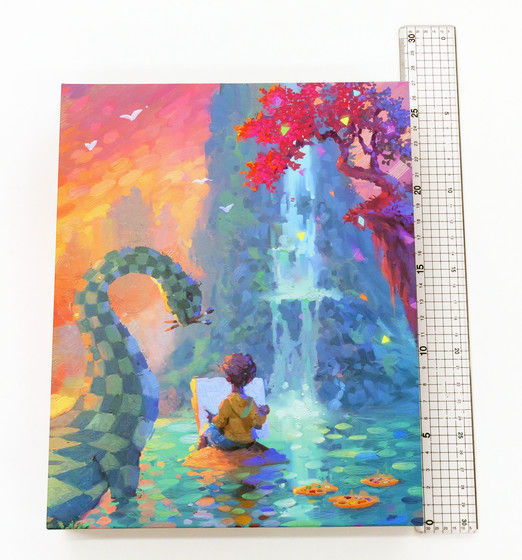
When placed next to the basic version, the pictures connect.

The back of the packaging contains a description of the game and a list of contents, and both the base version (left) and the expansion version (right) have a hole in the top of the back.
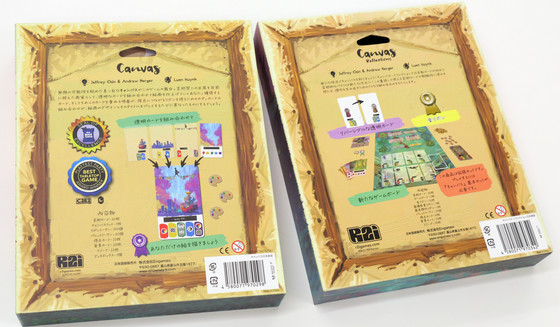
By using the hole on the back of the packaging, you can hang it on the wall like a painting.
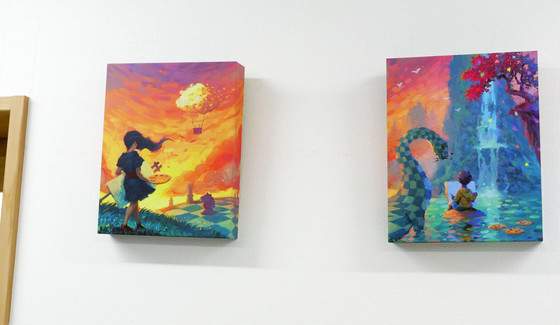
The number of players and playing time are listed on the side of the package. 'Canvas: Reflection' can be played solo or with up to five people. The target age is 14 years old and up, and the playing time is about 30 minutes.
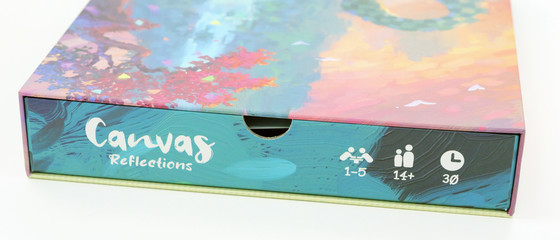
Slide it like a drawer to remove the contents.
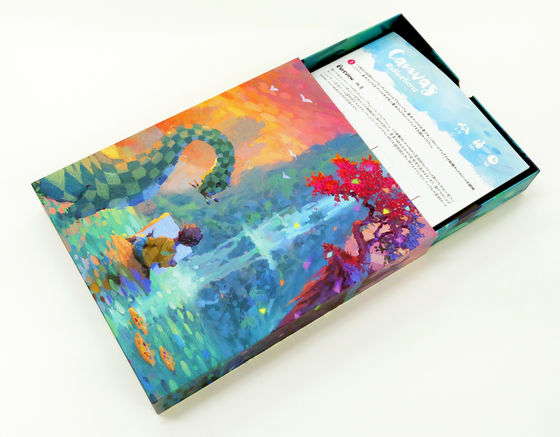
The contents include cardboard tokens for scoring etc., a thick, wooden playing board, an instruction manual in Japanese, various cards, sleeves, and a plastic bag with a zipper to store the tokens and cards.
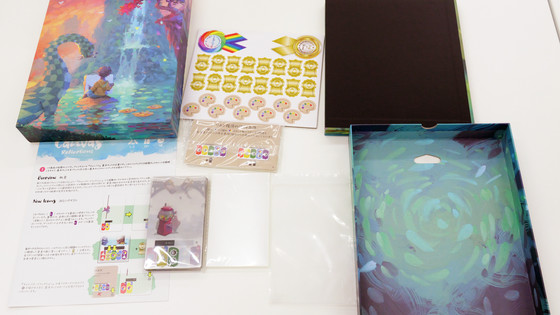
When you open the playboard, it looks like the image below. The long side is about 60 cm, so you need a fair amount of space to play.
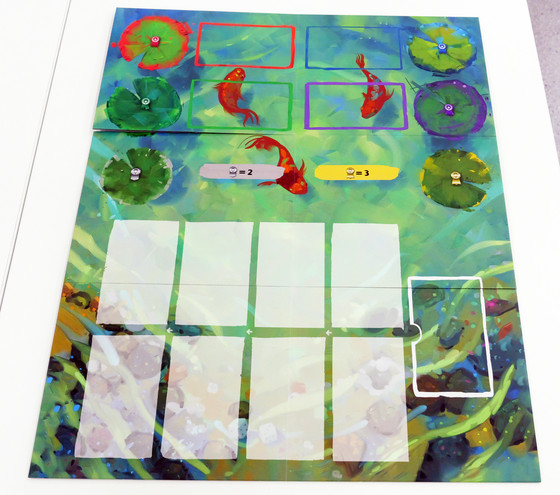
The top left of the image below shows the basic version of the playmat. While the basic version's mat is made of cloth, the expansion board is made of thick, sturdy paper and is more than twice as large.
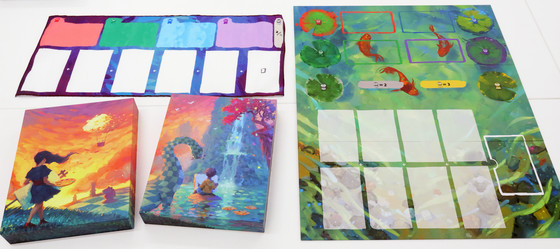
The cards consist of 8 'score cards' with the scoring conditions written on them, and 10 'background cards' with the background of the painting. By combining them with the 12 'score cards' in the basic set, you can try out a wider variety of scoring conditions, so you can enjoy the game in different ways no matter how many times you play. In addition, the background cards have nothing to do with the score or victory conditions, but the background is also important in creating a better painting, so adding 10 new cards to the 20 in the basic set should stimulate your artist instincts.
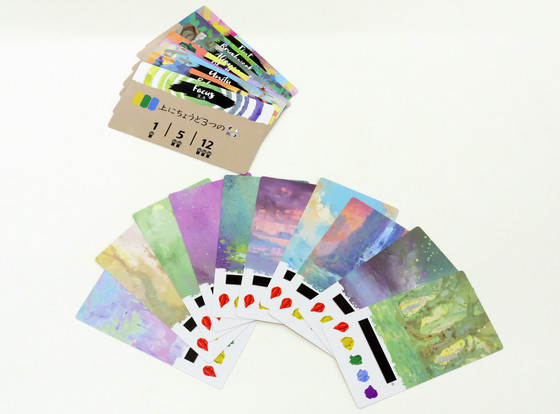
And there are 30 'art cards' made of transparent plastic. Since you play with 90 cards, including the 60 art cards in the basic set, not only have the number of cards you can use increased, but the range of card combinations has also increased significantly. In addition, the 30 art cards added in 'Canvas: Reflection' are reversible, so you can use both sides. For example, in the image below, I have a card with a picture of a rabbit with the word 'Birth' written on it.
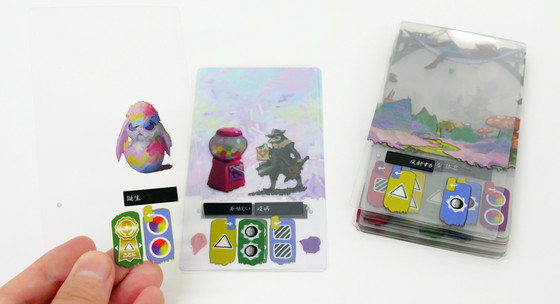
When you flip the card over, the title changes to 'Fantastic' and the picture changes to a dragon-like creature. In addition, the icons related to points are also reversed when you flip the card over, doubling the range of strategies.
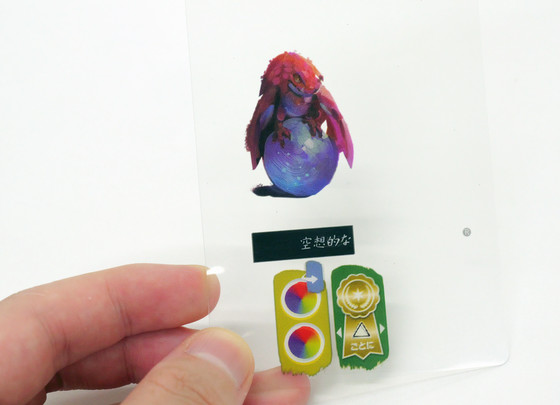
The cards will be a mix of basic and extended versions, but the extended version cards have an 'R' icon as shown in the red frame in the image below, so it's easy to distinguish them when putting them away.
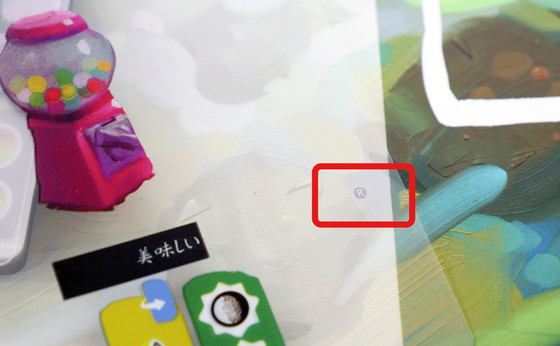
The basic way to play is to collect three of these transparent 'art cards', place them on top of the 'background card' and put them in a sleeve to complete 'one picture'. While you can get a high score by looking at the score condition cards, it is also recommended to pursue art and complete a wonderful picture.
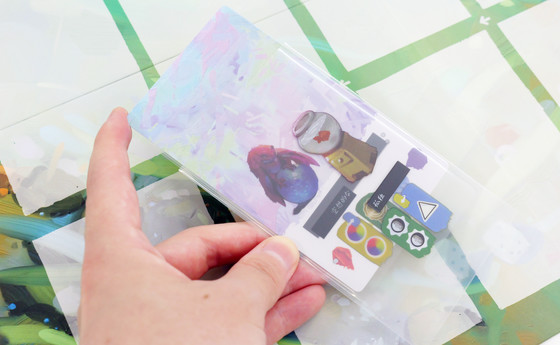
The red, blue, green, purple, and silver scoring tokens are from the basic version, but several new tokens have been added to Canvas: Reflection. First, the large gold token in the upper left of the image below is the 'Best Prize' ribbon, which is awarded to the player with the highest score at the end of the game. The small gold tokens are newly added scoring ribbons, which also expand the range of strategies. The large rainbow-colored ribbon is the 'Best Masterpiece' ribbon, which is awarded to the player who completed the most amazing painting at the end of the game, so you can also play in a style that prioritizes the completion of the painting over the score. In addition, 20 palette-shaped tokens were included in the basic version, but 10 new tokens have been added. The increased use of palette tokens is also an important point of the expansion version.
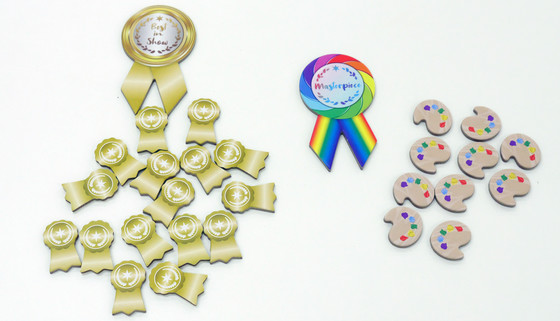
I placed each token on the playboard and selected four score condition cards. Although you can choose the score cards randomly from the 20 cards in the basic version and the expansion version, the instruction manual had a 'recommended scenario,' so I used that as a reference and chose the four new score cards in the expansion version: 'Alignment,' 'Structure,' 'Focus,' and 'Shade.'
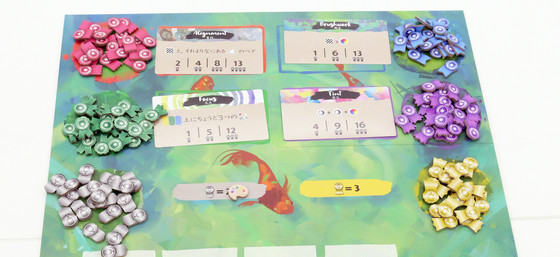
The art cards are mixed thoroughly with 60 basic cards and 30 expanded cards.
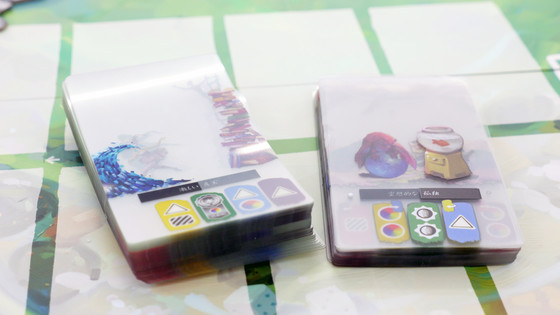
The shuffled cards are stored in the deck box that comes with the basic version. This deck box cannot hold all 90 cards, so set aside about 30 cards that will not be used in this game.
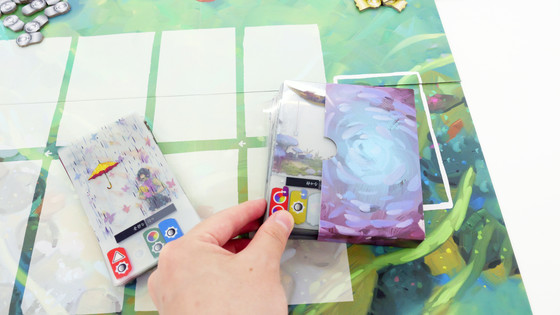
Take cards one by one from the top of the deck box and arrange them on the playboard. There are 8 art cards that appear on the board in the expansion version. Since there were 5 in the basic version, players have more options to choose from.

The board is ready when you line up a total of eight art cards, four on top and four on the bottom. Each player is given three sleeved background cards and six palette tokens, and the game begins.
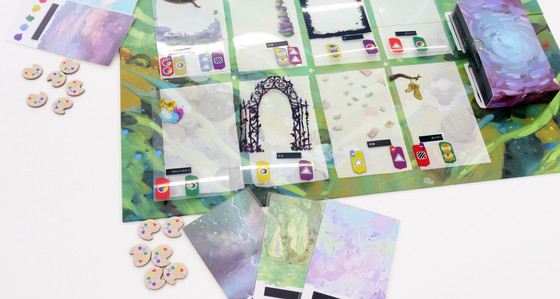
The overall picture after preparing the game looks like the image below.
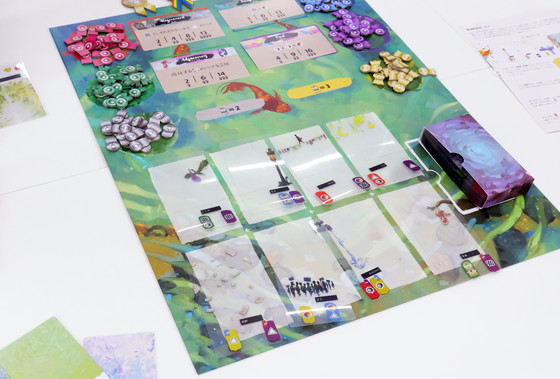
On your turn, you can either 'take an art card from the field into your hand' or 'combine three art cards from your hand to complete a picture.' First, you need to collect art cards, but you can only get free art cards from the two cards farthest from the deck box. For example, in the image below, the player selected the second card from the deck box.
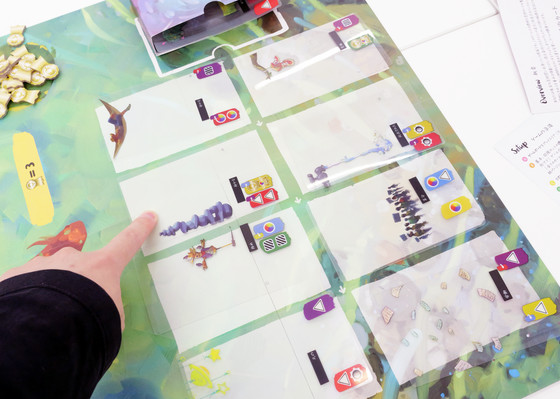
In this case, you need to place palette tokens on all four art cards that are farther from the deck box than the card you selected. Because you need to place palette tokens on art cards on both the top and bottom rows, more palette tokens are consumed than in the basic version, and there seem to be more cases where you don't have enough palette tokens to get the card you want.
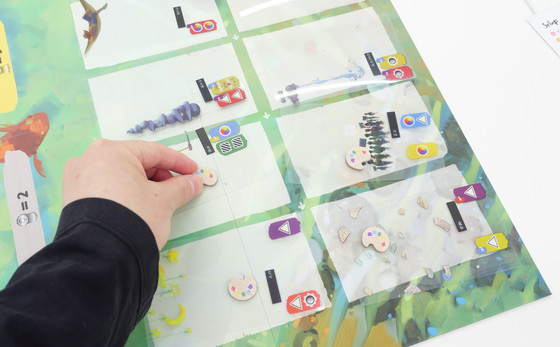
When a card is taken from the field, slide all of the art cards on the same row as the taken card away from the deck box and add one new card from the deck box.

When you acquire an art card, if there is a palette token on it, you can add the palette token to your hand as well. In this way, you can collect the art cards you want by managing your palette tokens.
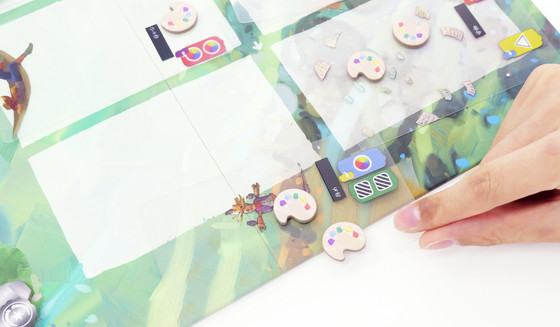
When you have three or more art cards in your hand, you can 'complete a picture' on your turn. Three art cards are stacked in a sleeve containing a background card to create a single picture. Each art card also has a modifier such as 'ancient' or 'heavenly' or a noun such as 'duty' or 'revolution' written on it, and when they are stacked together, a title such as 'Ancient Duty' is completed. When a player completes a picture, they declare the title 'Ancient Duty' when they play it.
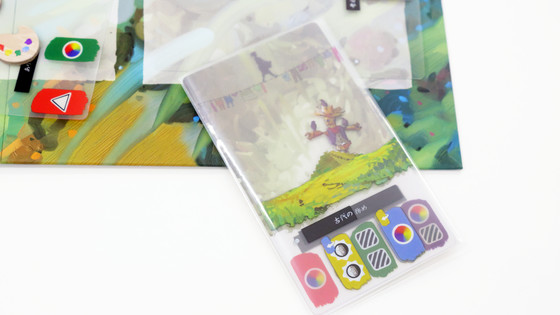
At this time, the icon under the title is the 'evaluation element' and you can earn a 'score ribbon' by referring to the evaluation card. For example, in the picture below, since the evaluation condition of '2 monochrome circles and 1 rainbow circle' was met, the 'purple ribbon' that corresponds to that evaluation condition was obtained.
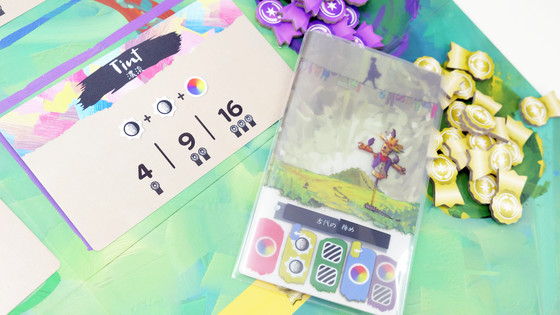
The completed picture is kept along with the ribbons that were earned. These are used to calculate the final score. Repeat this process until all players have completed three pictures, and the game ends.
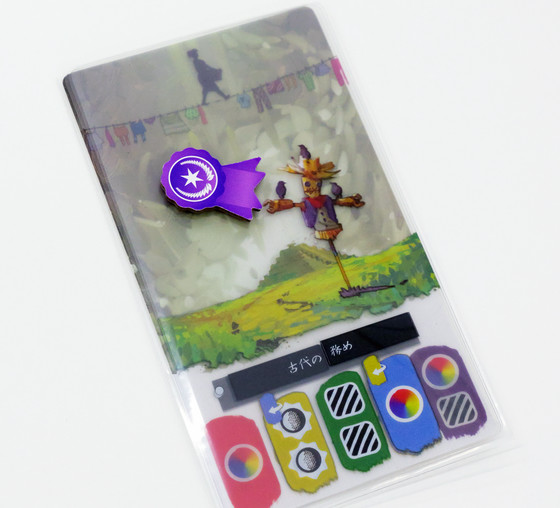
There are up to four different types of score cards, so you can get ribbons of multiple colors for one picture. Also, art cards have special 'silver ribbon' conditions, so if you meet the conditions, you can get even more points.
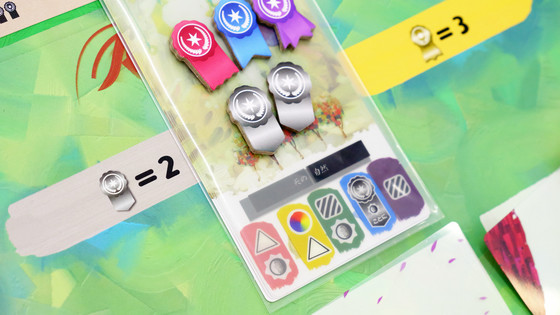
In addition, 'Gold Ribbon' has also been newly introduced from 'Canvas: Reflection'. Even if you are unable to fulfill the score condition cards, you can still collect gold ribbons using only the art cards in your hand, so the range of tactics has become wider.
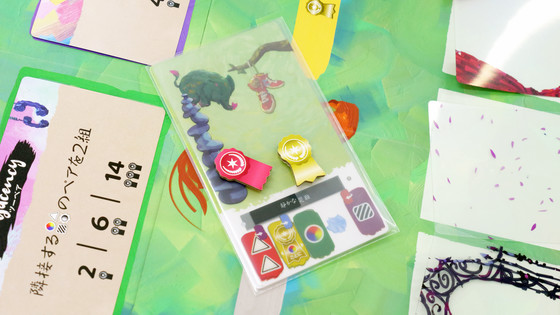
You acquire one art card per turn, and once you have three you can complete the picture at any time. However, you can only have five art cards in your hand, so you must complete the picture on your next turn after you have five. Therefore, it is important to have a strategy of when to complete the picture while checking the art cards in play.
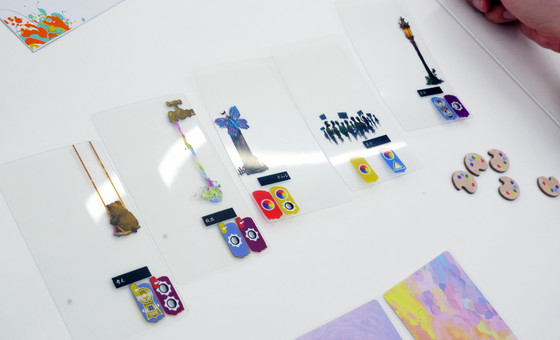
An important new feature added in 'Canvas: Reflection' is the addition of reversible art cards. For example, the player below has a card titled 'Quiet' with the evaluation elements 'two rainbow circles' on the left and 'diagonal square' on the right. If you look closely at the evaluation elements, you will see an arrow that flips them over.
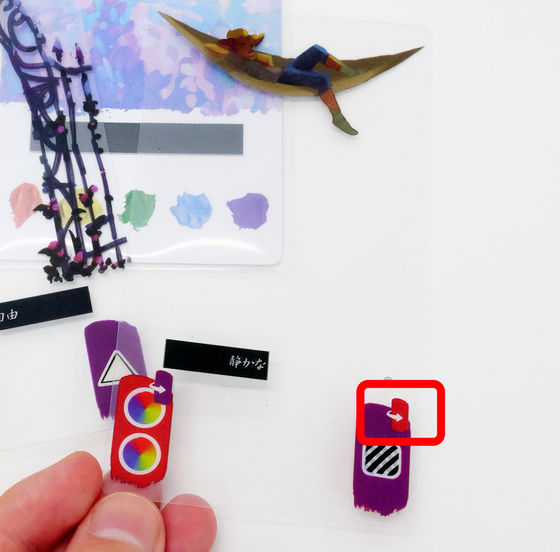
So I flipped it over, and it turned into a card called 'Rest' with a 'diagonal square' on the left and 'two rainbow circles' on the right. Since the cards are stacked, it is important to know where the evaluation elements are located, so flipping cards is quite useful. The number of combination options has simply increased, and this has also greatly expanded the range of strategies.
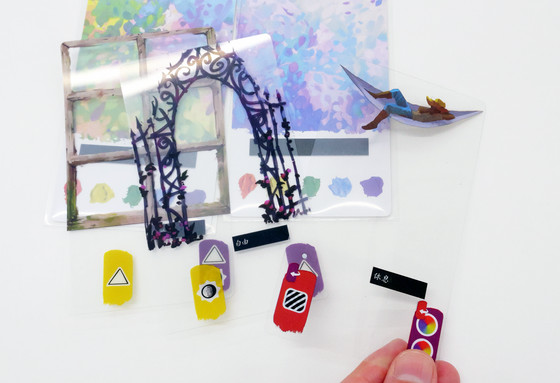
Once everyone has completed the three pictures, they count the ribbons in their hands and add up their points. For information on how many ribbons of each color you have, refer to the points written on the score card. For example, the following player got 2 points for one red ribbon, 6 points for two green ribbons, 9 points for two purple ribbons, 2 points for one silver ribbon unconditionally, and 3 points for one gold ribbon, for a total of 22 points. According to the 'scenario' used as a reference for the score condition card, the 'target bonus is 32 points,' so this result was quite disappointing.
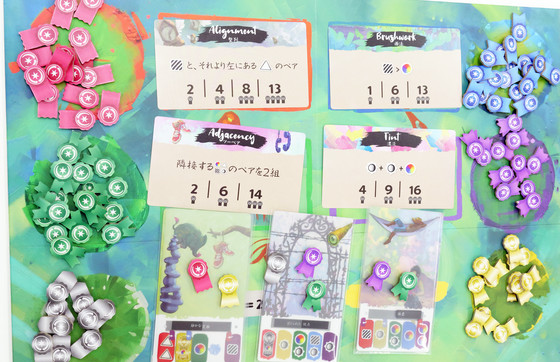
The highest score was achieved by the player who earned 38 points. The player with the highest score received a large gold ribbon as the grand prize.

Finally, each player chooses the most 'artistically excellent work' from among the completed paintings and puts it on the table. The four submitted this time were 'Forbidden Viewpoint,' 'Heavenly Nature,' 'Ancient Duty,' and 'Child Emanation.' All players will discuss and decide on the 'Best Work Award.'

The game was praised for having a background similar to a movie story, and the best game of the year was 'Ancient Duty.' The best game creator will be awarded a rainbow ribbon.
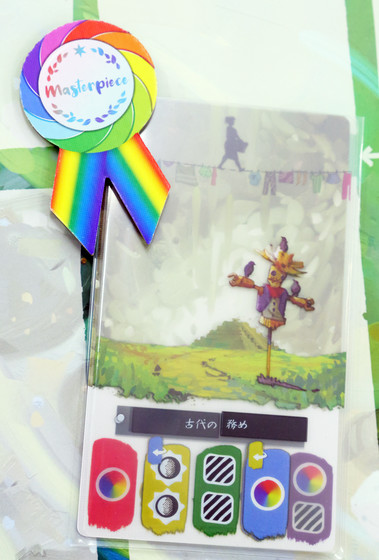
'Canvas: Reflection' is an expansion that has greatly changed the scope of play, without compromising the very easy-to-play feel of 'Canvas' and the original fun of combining transparent cards to create pictures, but with the number of art cards in play increased from 5 to 8, cards now have front and back sides for more applications, and new evaluation cards and gold ribbons for more ways to score. An editorial staff member who has played 'Canvas' said, 'Although it was originally a very interesting game, the parts that felt a bit monotonous and unsatisfying while playing have been accurately resolved, and it has evolved into a game that can be played infinitely.'
Furthermore, when playing 'Canvas,' some players got excited saying, 'I didn't get any points, but I created a very finished painting,' and by having this incorporated into the game as the 'Best Masterpiece Award,' it felt like the 'completing the painting' aspect became even more interesting.
The Japanese version of 'Canvas: Reflection' can be purchased from the Engames Shop as well as on Amazon.
Amazon | Canvas: Reflection Japanese version | Board games

Related Posts:






